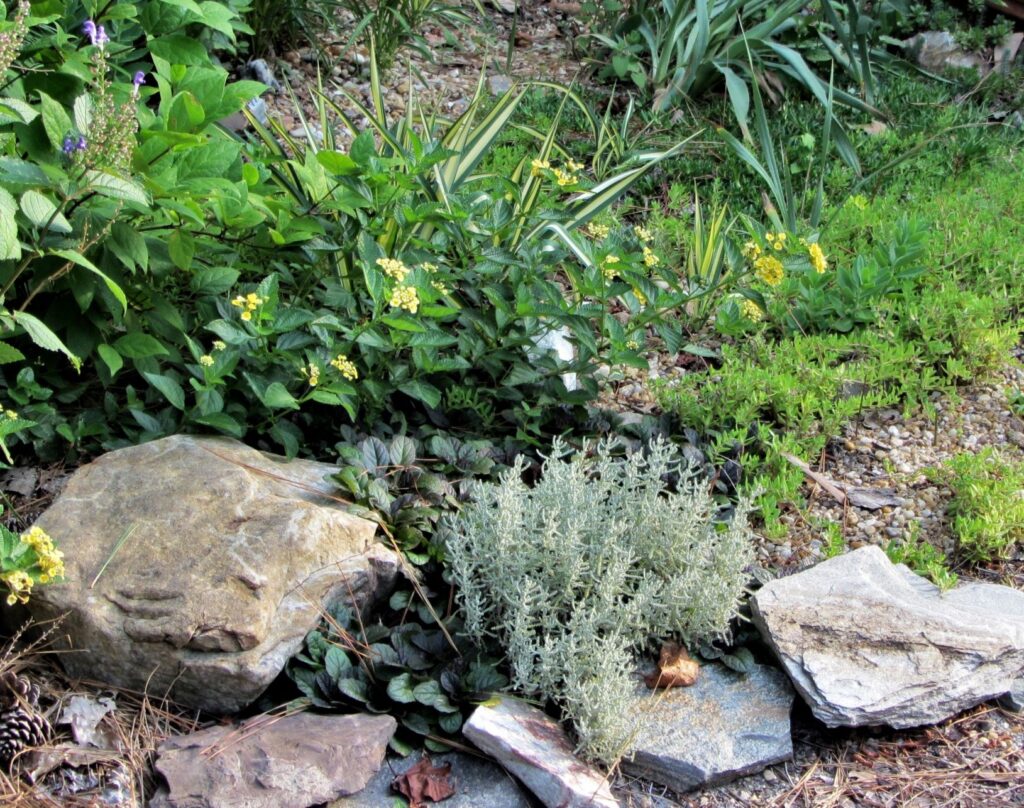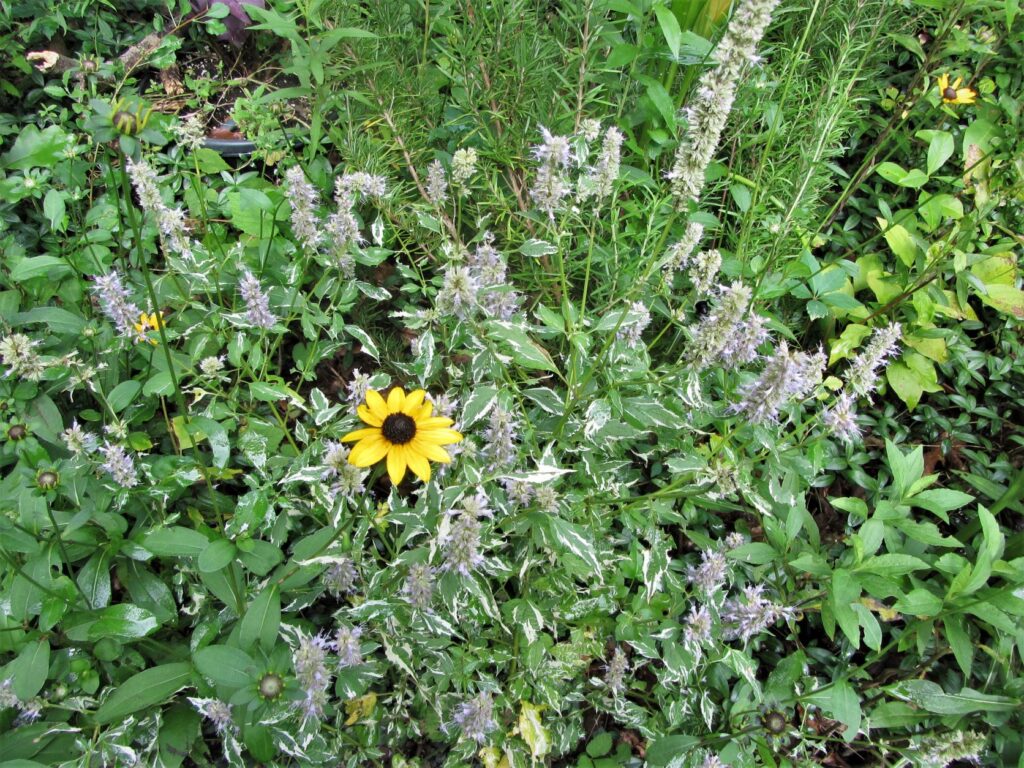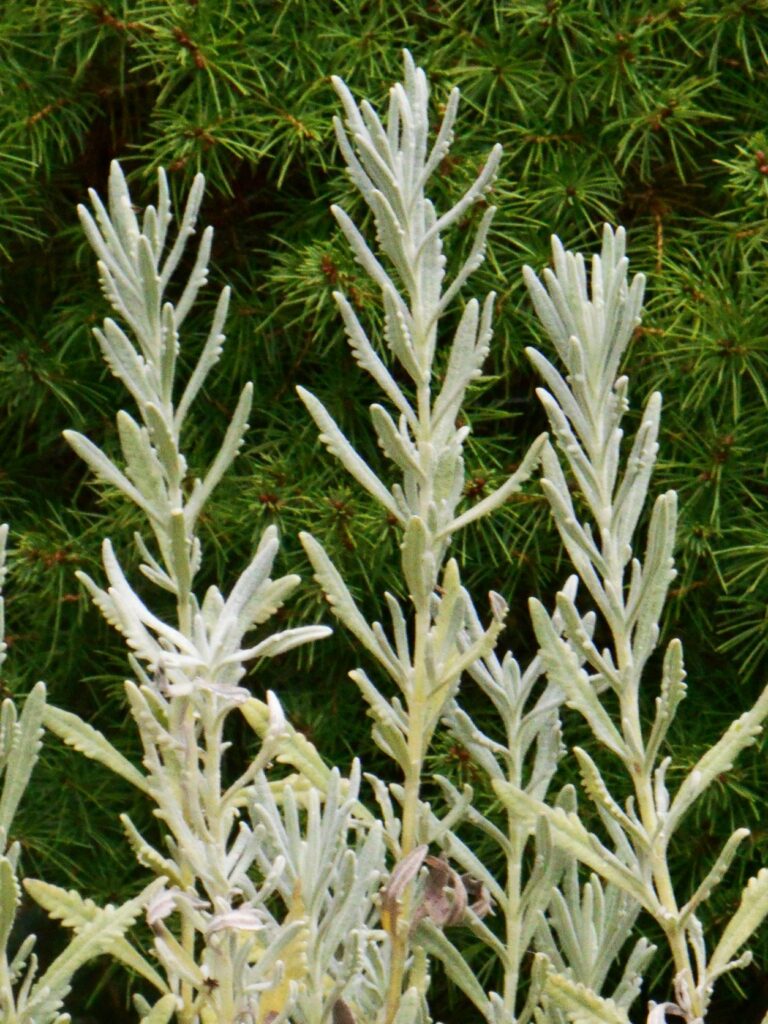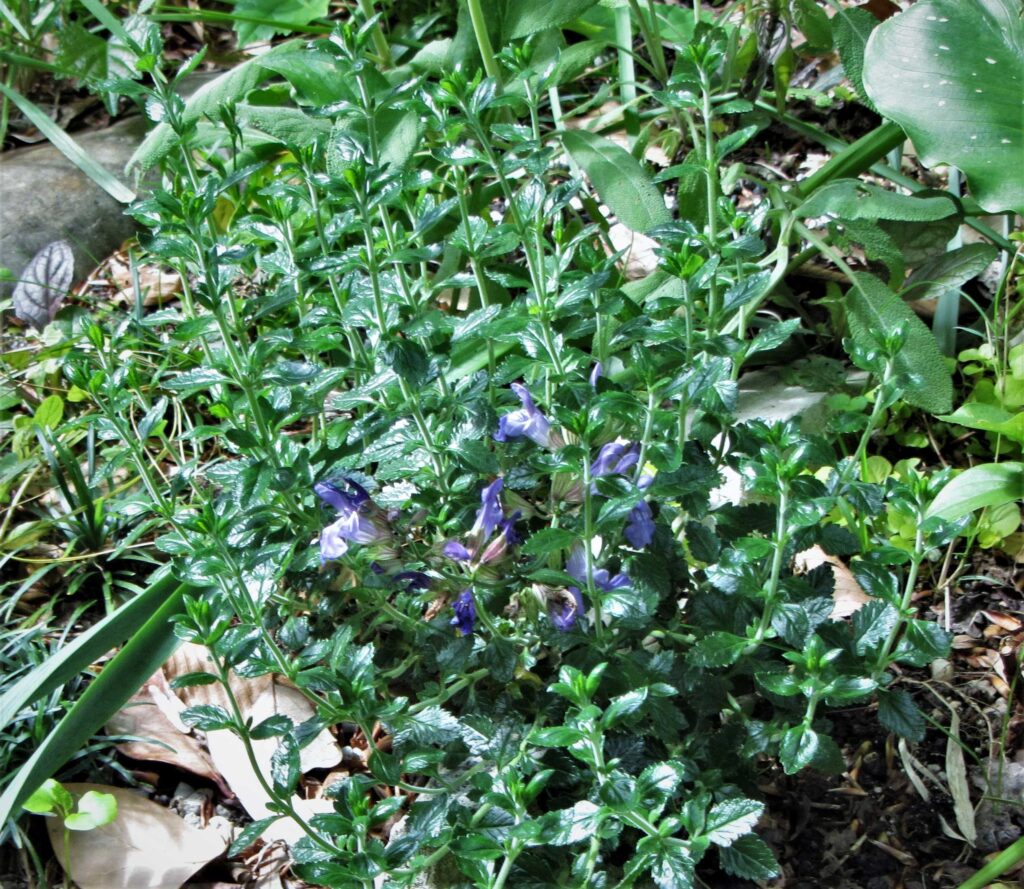Landscaping with Herbs in Williamsburg
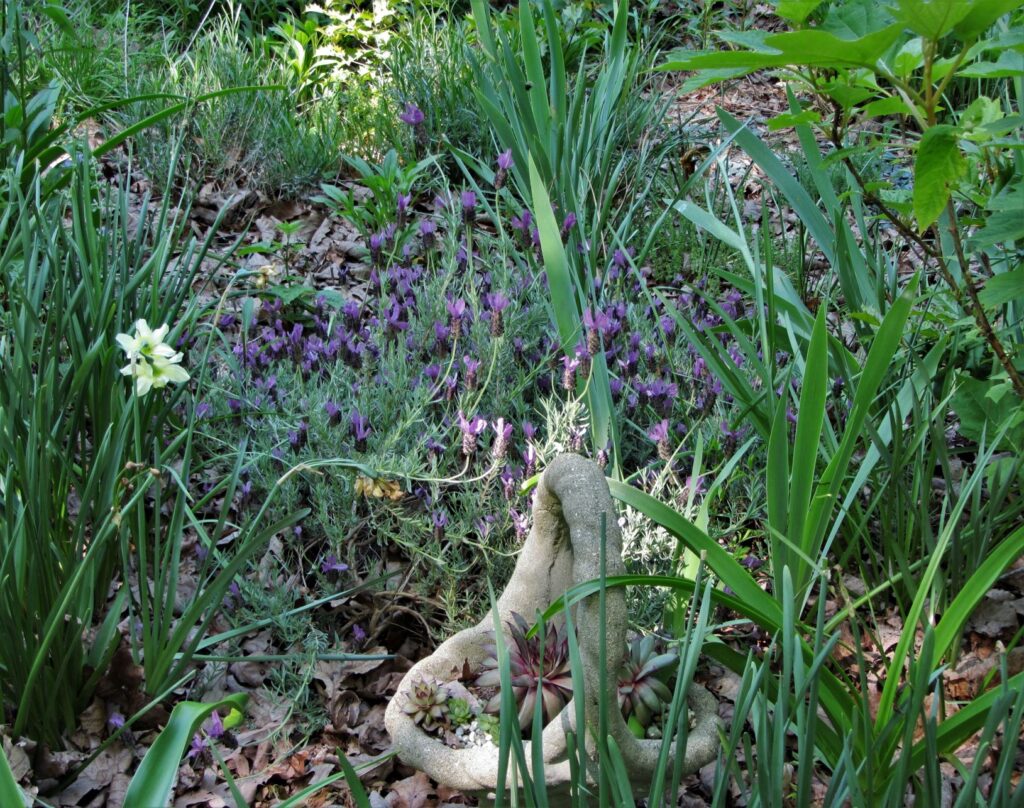
Lavandula stoechas, Spanish lavender, blooms in mid-spring to early summer. It is the most shade tolerant evergreen lavender that grows well in our area.
Once upon a time, I found herb gardening a topic of mystique and mystery. Maybe it was the herb gardening books I found, with their illustrations of medieval knot gardens, and the cute little pots of culinary herbs grown on the wide, sunny windowsill of someone’s gourmet kitchen. Or maybe it was learning that many herbs prefer a Mediterranean climate with dry, rocky soil and lots of sunshine. How could I replicate that in Virginia?
It may have been the complicated formulas for mixing potpourris using exotic ingredients like ‘orris root,’ or the instructions for blending teas and making tinctures. It wasn’t until I put the books away and began touching, smelling, and working with the plants that I understood how simple herb gardening can be.
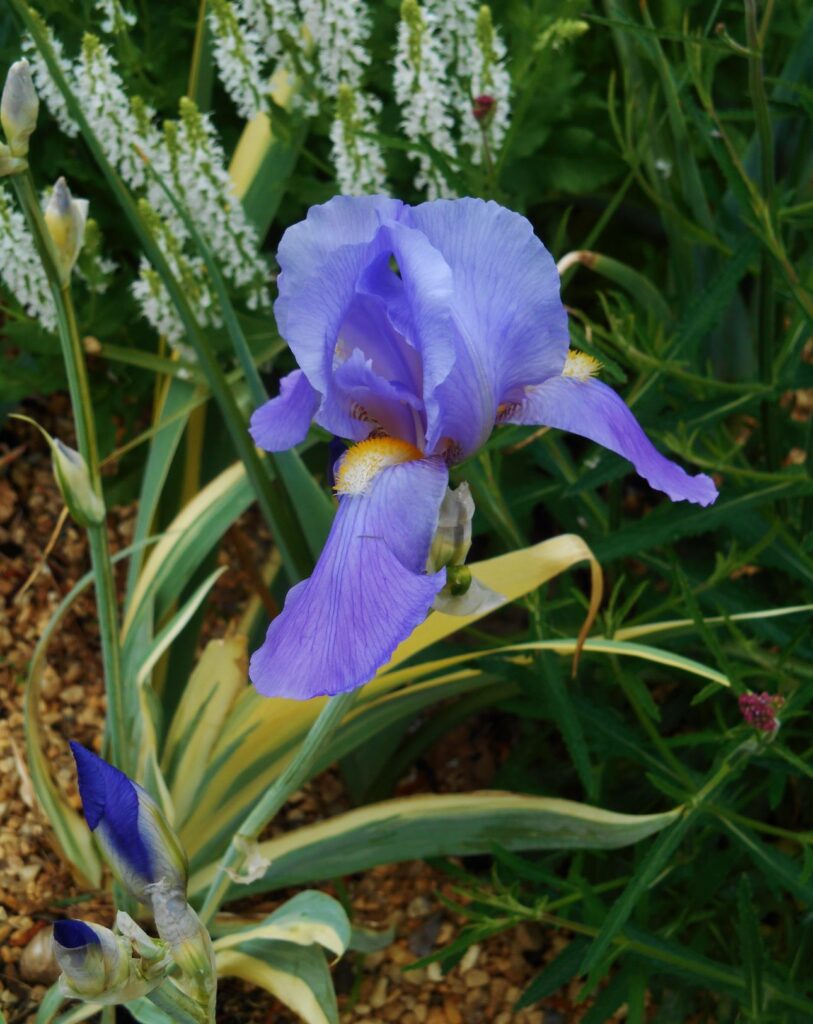
The rhizomes of Iris pallida are dried and ground to make orris root powder. Irises grow very well with most herbs, and some sources consider this species of Iris to be an herb.
Just Wildflowers in Another Land
Do you grow herbs? If you do, you are probably grinning and shaking your head in agreement. If you don’t, you may also feel a little overwhelmed by the topic. As a novice gardener I believed there was something very challenging about growing herbs. Learning about all the different kinds of herbs felt even more challenging.
Herbs, just wildflowers in another land, are among the simplest plants to grow. They demand little attention and few ‘inputs’ from the gardener since their needs are few when properly sited. Planting perennial herbs in our gardens allows us to garden more sustainably with less waste, less work, and a positive environmental impact.
I will always remember the late December afternoon when I was admiring a fresh, vibrantly green flowering hedge growing along a fence in Virginia Beach. The hedge stood about 4’ tall with lush, dense, needle covered stems twisting this way and that, adorned with tiny blue flowers. What could it possibly be?

Some varieties of rosemary may grow to 6′ tall if not regularly trimmed. Use rosemary like an evergreen, woody shrub.
A closer examination filled my nose with the wonderful fragrance of rosemary. That was probably my first experience with herbs used as just part of the landscaping. There was no formal ‘herb garden’ and no cute little ceramic pot. These were small shrubs, grown as rosemary is intended to grow in poor, sandy or rocky soil, and full sun, with absolutely no pampering. While many rosemary varieties are hardy to Virginia Beach’s Zone 8, rosemary ‘Arp’ is hardy enough to remain evergreen and flowering through a Williamsburg winter, too.
Herbs Inspire Joy
Herbs may be the most enjoyable of all plants to grow for their rich fragrances and beautiful form. They are essential parts of any sort of therapeutic or learning garden planted for children, the elderly, or the disabled because they are meant to be touched, smelled and enjoyed. Herbs also may be cut for the vase, lending additional color and fragrance to floral arrangements.
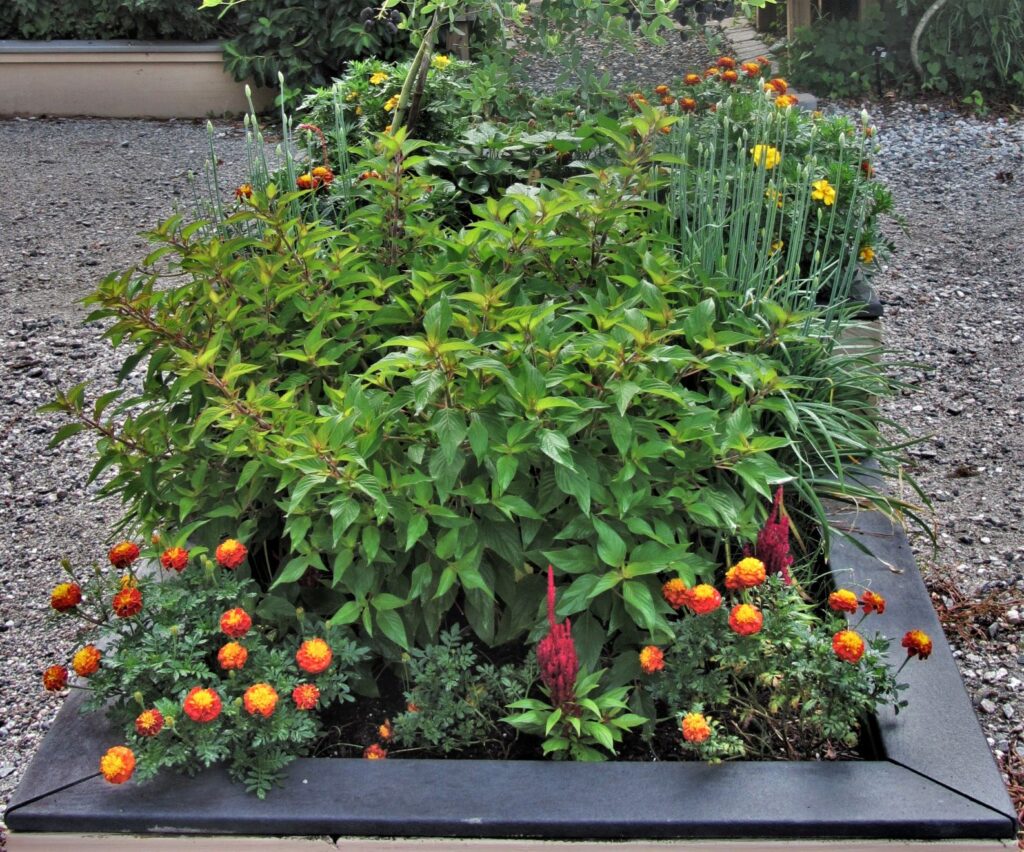
Pineapple sage and chives grow with marigolds in this section of the Therapeutic Garden at the Williamsburg Botanical Garden.
Herbs have been considered magical, healing plants since ancient times. They are mentioned throughout history in lore and legend, carry symbolic meanings, and may be associated with ancient archetypal gods and goddesses. Fresh and dried herbs were burned as incense in ancient temples and as offerings in ceremonies. Herbs are discussed in ancient manuscripts, including those later included in the modern Bible.
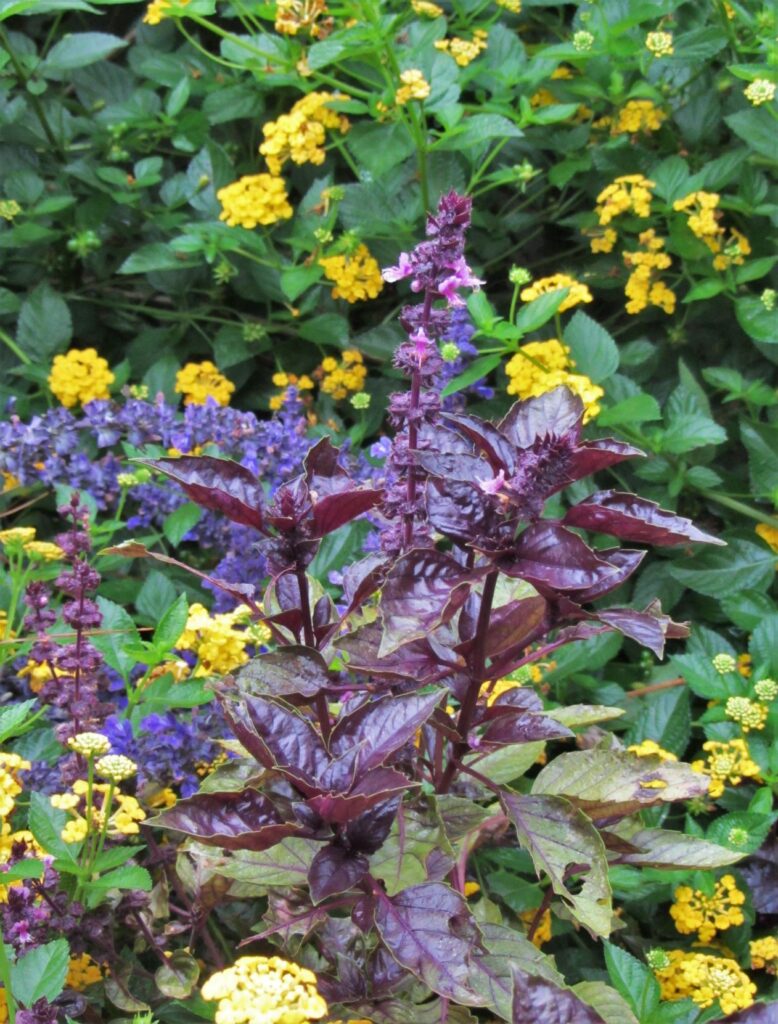
‘Dark Opal’ basil blooms over several months, attracting hummingbirds and other pollinators. Basil may be inter-planted with tomatoes, eggplants, and other vegetables as well as with other flowering plants.
The Power to Heal
Contemporary science has isolated and named the bio-active components that enable herbs to heal and soothe us. Now we understand why herbal teas, tinctures and salves heal a wide variety of maladies, and help us maintain good health. Herbal components are extracted and used today in a range of commercial medicines.
Herbs have volatile oils in their stems and leaves that give them a distinctive fragrance and flavor. Here is a container arrangement composed of mostly lemon scented herbs.
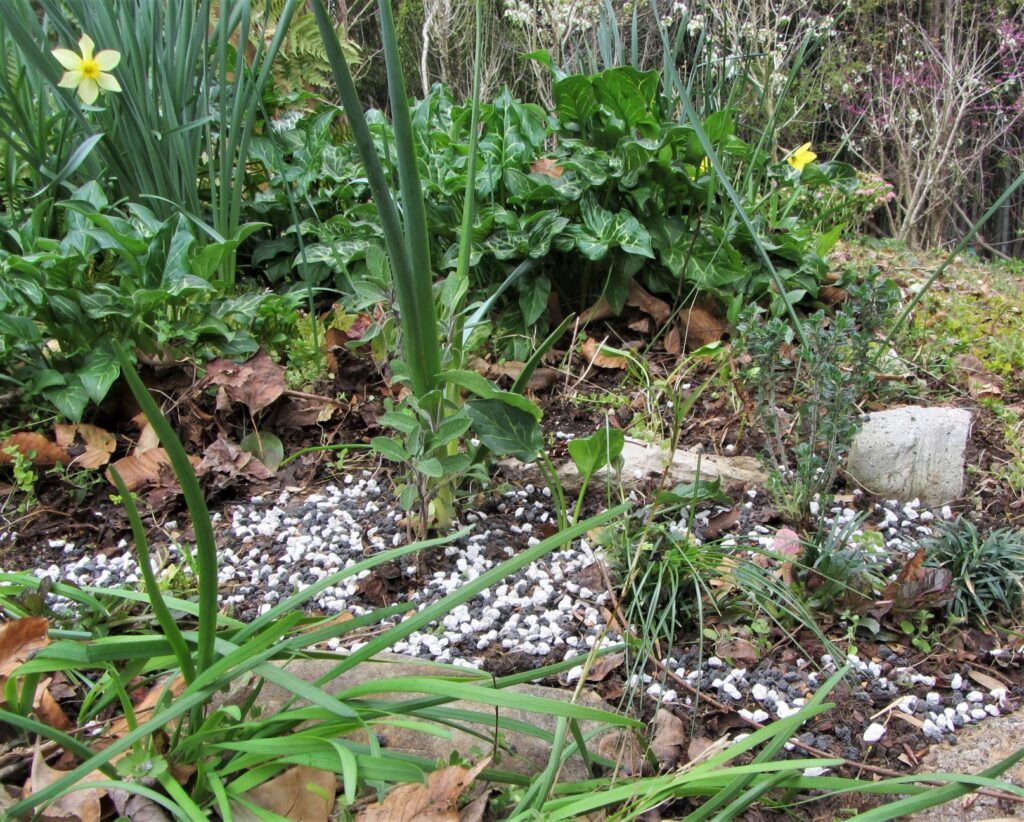
Young culinary Salvia (left) and germander (right) grow in a narrow border at the end of the driveway. They will anchor this dry sunny bed as spring bulbs and other plants come and go with the seasons.
Herbs generally retain their character once dried. Some, but not all, herbs are evergreen perennials. Some, but not all, are edible. Some, but not all herbs are medicinal. Many of our most popular herbs belong to the mint family or to the Salvia family. Their strong fragrances make them distasteful to both deer and rabbits. Though herbal flowers are favorites of pollinators, the essential oils in their leaves repel many insects, including mosquitoes, ants and flies.
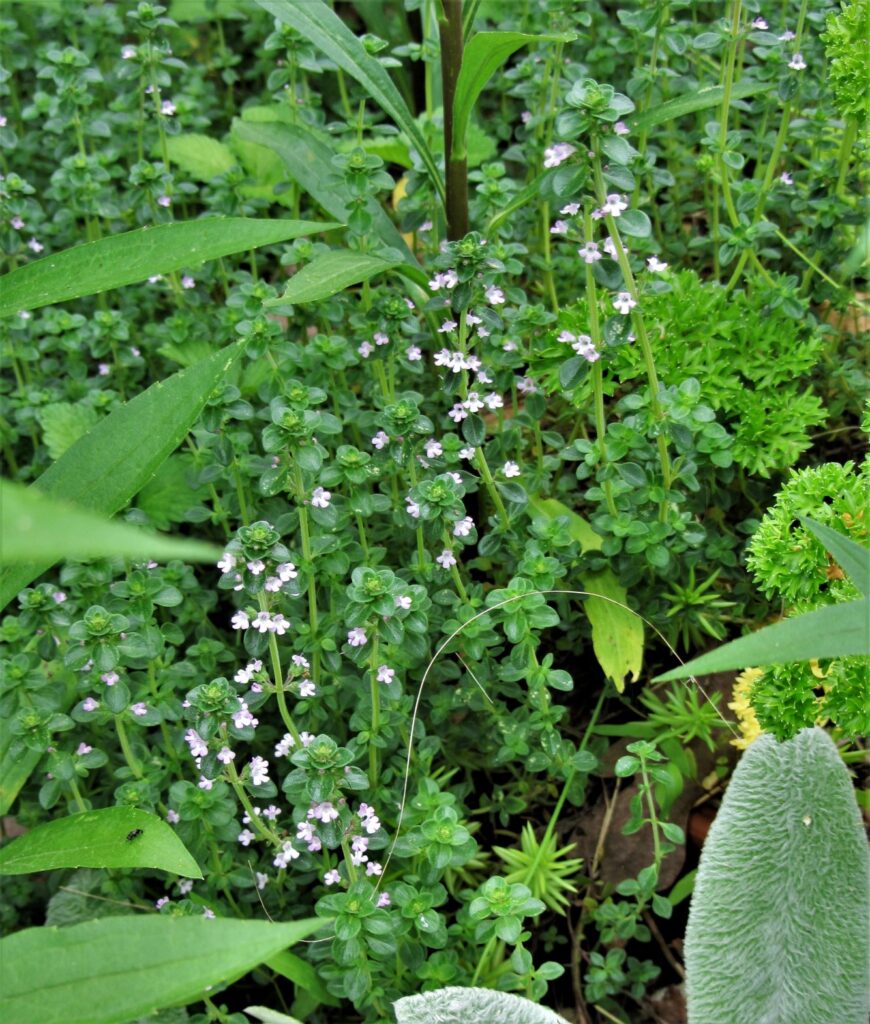
Thyme has many uses both in cooking and folk medicine. Its essential oils soothe sore throats.
Culture
A few herbs are either true annuals or biennials, which live for only a season or two. Others may be tender perennials in their native range, like scented Pelargoniums, which we treat like annuals. It is important to learn this about the herbs you grow so that you know what to expect from them year to year.
Nearly all herbs prefer 6-8 hours of sun each day. They develop the best fragrance and flavor in the sun, though many will continue to grow in partial shade. Herbal flowers attract bees, butterflies and some even draw hummingbirds. Their needs for water and nutrients vary. Soft, herbaceous herbs like basil and parsley need a bit more consistent moisture than do woody shrubs like rosemary and lavender, which are very drought tolerant.
You can mix herbs into a flowering border, a planting of shrubs and perennials, container gardens, and into your vegetable garden. Many gardeners mix flowering herbs among their vegetables to attract pollinators. Some perennial herbs, like dill and fennel, develop long taproots that burrow deeply in search of water and nutrients. They help condition the soil for plants growing nearby, breaking up compacted soils and bringing minerals up to the surface layers.
Mixing herbs among annuals or other flowering perennials helps anchor a planting with a scented, flowering plant that performs over a long season. Evergreen herbs will carry a container planting or mixed border through every season of the year. Prostrate, or creeping rosemary works especially well to anchor container gardens. It remains shorter than other varieties and eventually cascades over the side of the container.
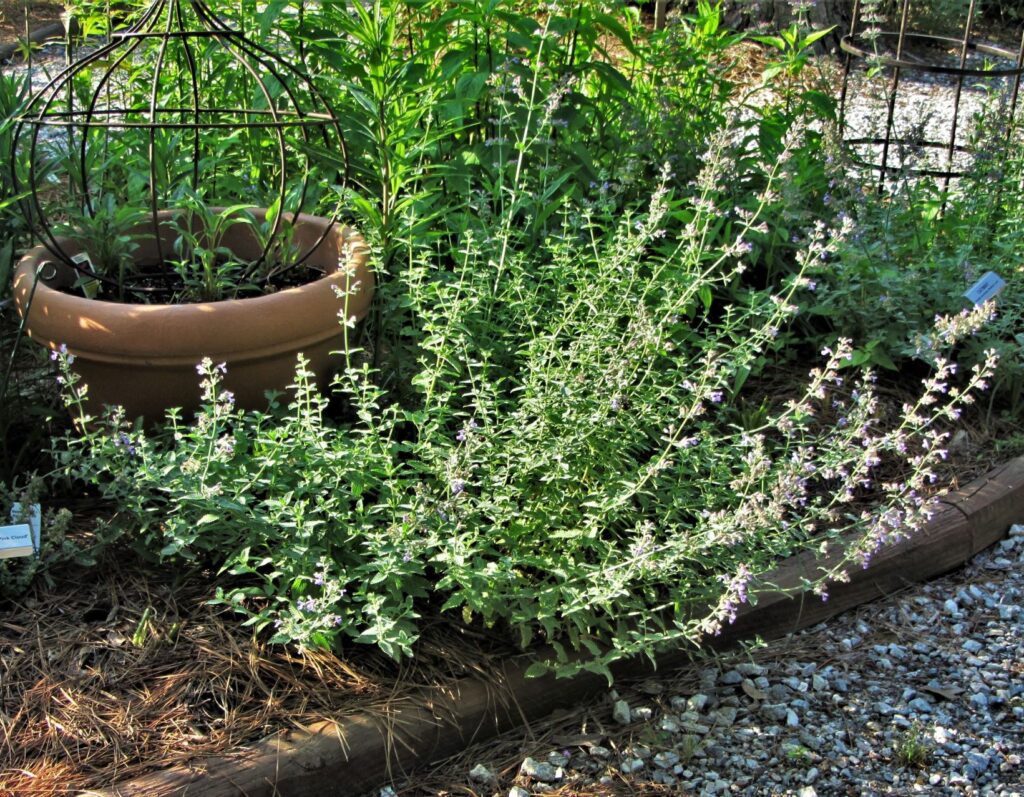
Agastache is a butterfly magnet. A member of the mint family, its leaves carry an essential oil that repels biting insects. It grows in the Pollinator Garden at the WBG.
Grow Herbs to Support Wildlife
Annual and tender perennial herbs like basil and mints bloom continuously over a very long season, attracting and supporting a variety of pollinators, including hummingbirds. Birds appreciate them too, hunting those insects that visit them and finding shelter within larger, woody herb plants. Plant basil in late April or May in our area and expect it to continue blooming until the first frosts of November. If you leave the flowers to go to seed, goldfinches and other small birds will feast on them.
The mint family includes Agastache, a flowering perennial grown more for its flowers than its leaves. Native Agastache, or hummingbird mint, is a magnet for butterflies. Unlike culinary mints, it doesn’t run all over the garden. It stays put where you plant it and its larger than usual flowers come in a wide variety of bright colors. Some recent cultivars even have variegated leaves.
Sustainable Herb Gardening
Most herbs remain healthy with few disease or pest problems. The worst thing a gardener can do to them is to coddle them with too much water or fertilizer. Too much water may cause their roots to rot. After all, a plant’s roots don’t have gills like a fish. They need some air pockets in the soil so they can breathe.
Too much fertilizer may stimulate a lot of growth with few flowers or may burn the plant. I prefer to limit fertilizers to dilute fish/seaweed emulsion applied to container herbs every few weeks while watering them. If planting woody herbs directly into the ground, improve the drainage of heavy clay soils with compost and grit. Lavender prefers a neutral or sweet soil and will grow better if planted with a bit of dolomitic lime in the planting hole, and perhaps scattered around on top of the soil around a new transplant. All herbs will appreciate a little balanced, organic fertilizer like Plant-Tone or Bio-Tone mixed into their soil at planting.
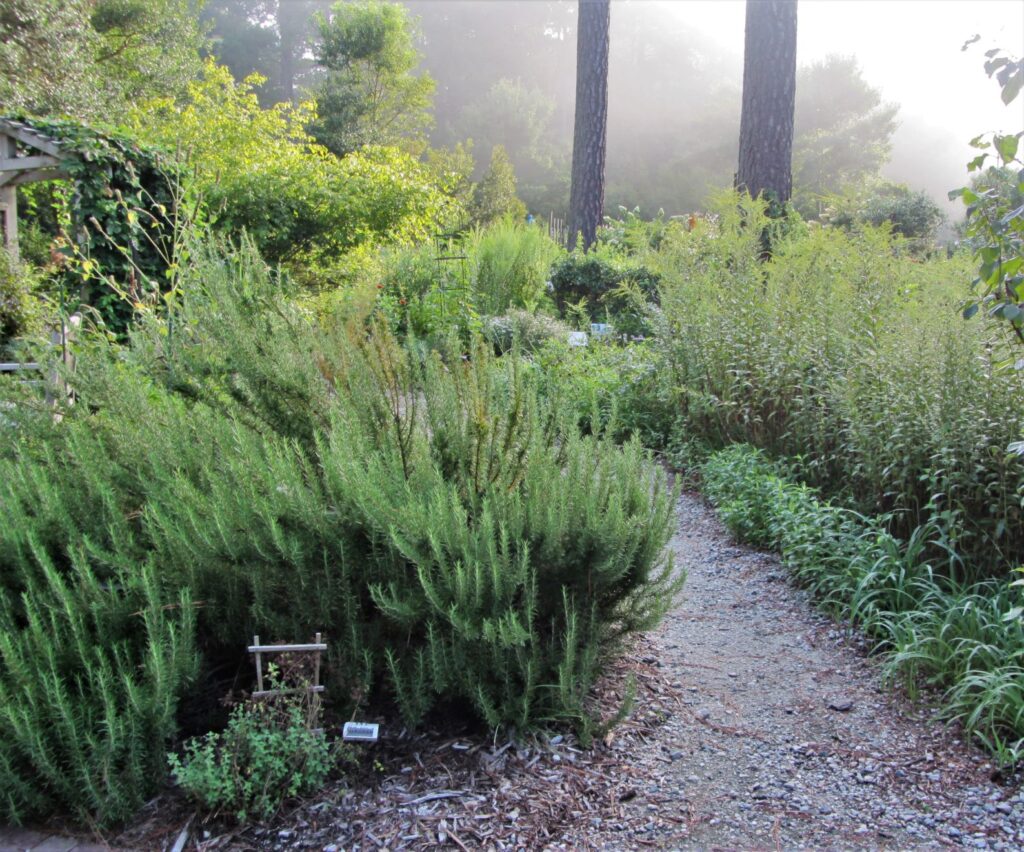
Rosemary grows in the herb garden at the Williamsburg Botanical Garden and Freedom Park Arboretum.
Mediterranean herbs like lavender, rosemary, Santolina, thyme and sages can develop fungal disease on their leaves if left wet too for long. Applying a gravel mulch under these plants helps them remain healthy. The gravel prevents rainwater from bouncing back up off the soil onto their lower leaves, and it reflects light and heat up into the plant’s interior on sunny days. This helps the herb’s leaves dry out more quickly after a shower or storm. Gravel mulch regulates water in the soil and insulates the roots from extreme heat and cold. Gravel mulch is especially helpful to herbs grown in containers.
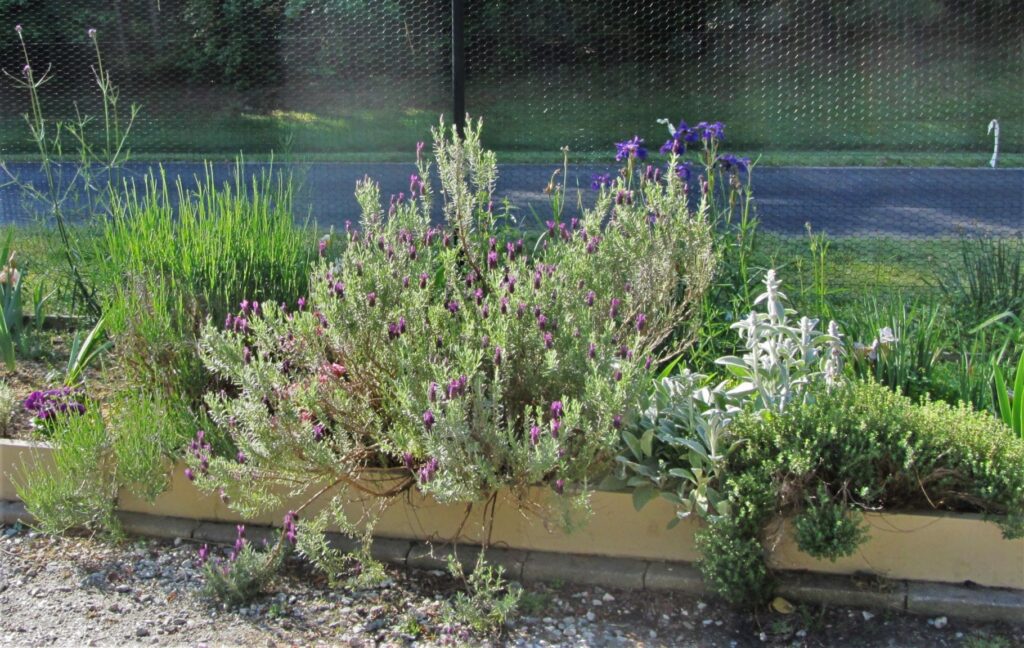
Herbs want regular trimming. Cut away dead wood in early spring and cut plants back after they bloom to maintain their size and shape.
Cut and Come Again…
Finally, use your herbs. Most herbs respond well to harvesting, pruning, and pinching back. You will end up with a larger, fuller plants if you cut them back from time to time. Some perennial evergreen herbs need at least an annual trim to cut out any dead wood and to stimulate new growth. Do this in early spring to prepare for the coming season. Remove flowering lavender stems while in bloom to harvest the flowers, or as the flowers fade to neaten up the plants. Prune lavender shrubs when flowering is complete, to shape them and control their size.
I have enjoyed growing many different herbs over the years and cultivated them in a variety of different situations. Any gardener who struggles with grazing deer or rabbits will find that their herbs are left alone. Squirrels tend to avoid digging in containers where herbs grow. Even better, herbs help protect plants growing near them because their strong fragrance can confuse an herbivore’s nose.

Scented Pelargoniums have edible flowers and leaves. These tender perennials may overwinter in our area with protection.
Evergreen Perennial Herbs for the Williamsburg Area
What follows isn’t an exhaustive list, but simply a mention of a few evergreen perennial herbs that are useful in the landscape and that grow well here in Williamsburg. Find most of these herbs available in local stores and farmer’s markets between now and late June. As with any gardening adventure, experimentation is the pathway to true learning. I’ll discuss other good landscaping herbs in future posts.
Lavender Lavandula spp.: L. angustifolia (L. officinalis), L. stoechas, Lavendula x intermedia and L. dentata grow successfully in our area. L. x intermedia ‘Phenomenal’ is an improved hybrid developed for the extreme heat and humidity of the American Southeast. L. stoechas, or Spanish lavender, is one of the earliest to bloom and can tolerate more acidic soil than some species. It has very fine foliage and also tolerates our summer weather. L. ‘Goodwin Creek Grey’ has especially attractive velvety leaves and is hardy to Zone 7.
These evergreen shrubs grow to between 18” and 24” tall and wide (check the information for the variety you purchase). Leaves and flowers are edible, have medicinal properties, and bloom in summer in shades of blue, purple, pink or white. Use cut flowers fresh or dried. This is an excellent landscape plant.
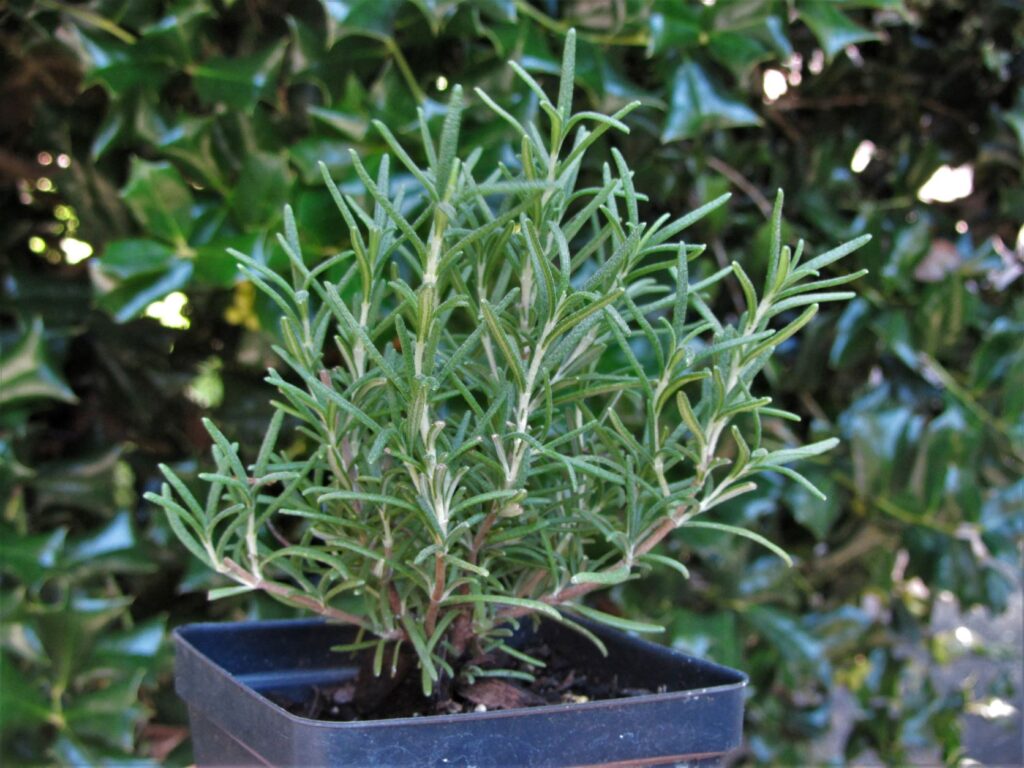
Find a wide variety of rosemary plants at local garden centers.
Rosemary Salvia rosmarinus Rosemary can grow into a woody shrub 4’-5’ tall and 4’ wide where it is happy. It works well as a foundation planting, a fragrant hedge, as a ground cover on sunny banks and slopes, as a screen for utility boxes, and in large containers. Some cultivars like ‘Arp’ and ‘Tuscan Blue’ may grow to 6’ tall. Others, like ‘Prostratus’ will spread up to 8’ wide, but grow to only about 18” tall. It is hardy to Zone 8, so will need winter protection when temperatures drop below 10F. All rosemary plants respond well to clipping and they can be trained into topiary forms.
You may know this herb as Rosmarinus officinalis, which was its name before its recent shift of genus. It has a long culinary and medicinal tradition. All the cultivars found locally are very good. Flowers may bloom in blue, lavender, pink or white. ‘Arp’ is the most cold tolerant, to Zone 6, and performs best year-round. Rosemary is extremely drought tolerant once established, grows a large root system, and blooms throughout the year.

Salvia ‘Berggarten’ grows with thyme, oregano, lavender and other herbs in the Therapeutic Garden at the WBG.
Culinary Sage Salvia officinalis is usually grown for culinary and medicinal use and its leaves are valued over its flowers. Many gardeners remove flowers before they develop to encourage the growth of more leaves for harvesting. This Mediterranean herb in the mint family has a strong and distinctive aroma. Its leaves are textured and a bit fuzzy in shades of green-grey, purple, grey and cream. The most common, widely available cultivars locally include S. ‘Berggarten,’ S. ‘Purpurascens,’ and S. ‘Tricolor.’
Sage needs full sun, well drained soil and will grow to about a foot to 18” tall and 2’ wide in Zones 4-8. Grow sage in a pot near your kitchen door, in a mixed border, rock garden, and in therapeutic gardens. Add additional sand, gravel or grit to your mix to grow sage well in a container, and mulch with additional gravel. Although this is a short-lived woody perennial, sage plants that fail commonly suffer root rot from wet soil.
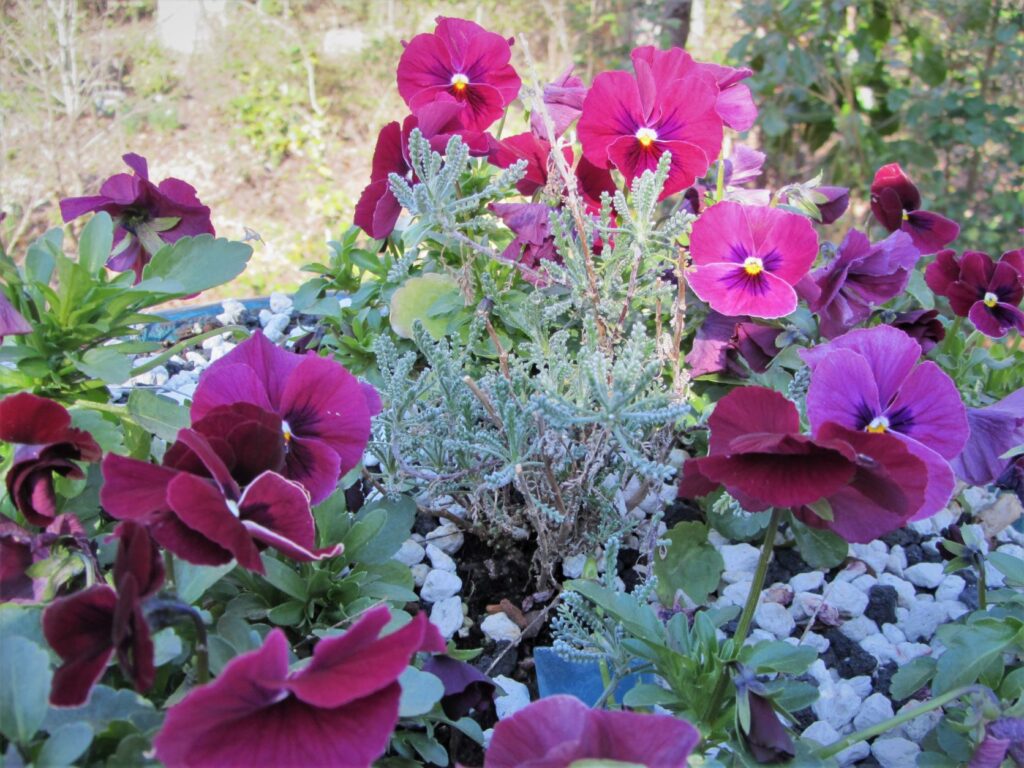
A tiny Santolina, salvaged from the reduced rack at the garden center in December, is already showing new growth in mid-March.
Santolina spp. belong to the daisy family and several species are grown for their fine foliage and for their small, daily like flowers. S. etrusca native to Italy, has beautiful grey stems and leaves that somewhat resembles lavender. It makes a good ground cover or edging plant in neutral, acidic or alkaline soil in Zones 6-9. This is a good plant for rock gardens and pollinator gardens and is the most commonly available variety in our area. Other species include S. rosmarinifolia, which has green stems and leaves, yellow flowers, and grows to about a foot tall, and S. chamaecyparissus, with grey foliage and yellow flowers.
Germander Teucrium chamaedrys may be confused with thyme until you touch and smell it. It doesn’t have the distinctive fragrance and is not used in cooking, though it has been used in herbal medicine. This Mediterranean herb in the mint family may be used for edging beds and in formal knot gardens because it holds its vibrant green leaves through the winter in Zones 5-9. It blooms with small pink or purple flowers in early summer. Trim the plant back after bloom for best growth and to maintain its shape.
Germander grow to 12” tall and 2’ wide on neutral to alkaline soil in full sun. Drought tolerant once established, this is another plant that wants good drainage to perform well over many years. Use germander as an edging or ground cover, on banks and in containers. It is a useful addition to a pollinator or wildlife garden.
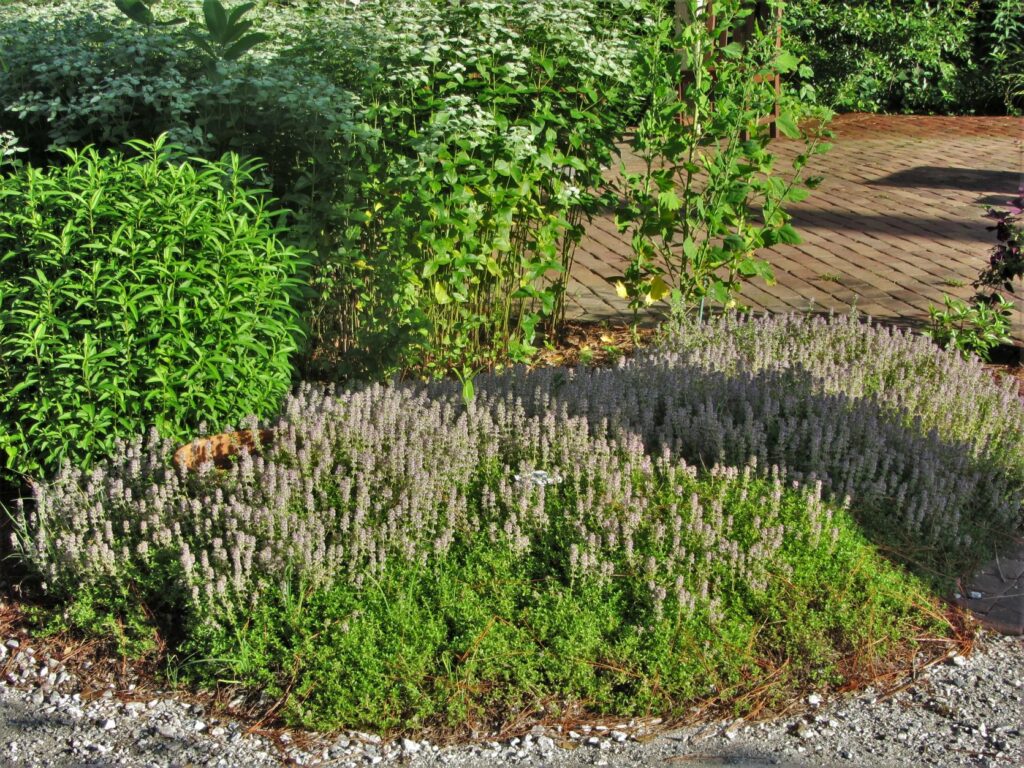
Thyme grows into an excellent ground cover.
Thyme Thymus includes several hundred species, and there are many different named cultivars. Thymus citriodorus, or lemon thyme, and Thymus vulgaris are the most common culinary species, with many named cultivars with unique fragrances and leaf variations. Thyme is a very low growing woody perennial that may be used to edge border, as ground cover, in containers, and on sunny banks. Expect Thyme plants to grow 6”-12” high and to spread. Its thin, wiry stems can root where they contact the ground.
Thyme is very drought tolerant once established. It requires good drainage and can not tolerate saturated soil for long periods. Although its tiny leaves look delicate, it is a tough, long lived perennial hardy to Zone 5. It prefers alkaline to neutral soil and grows well on rocky, sandy poor soil. Include thyme in rock gardens and try it in very difficult, sunny areas where other plants may perish.
Thyme has tiny flowers beloved by bees and other small pollinators. Beekeepers value thyme as it makes superior honey. It is an important culinary herb in many cultures, and it is an important medicinal herb.
Continue to:
Landscaping with Herbs Part II: Deciduous Perennial Herbs
Landscaping With Herbs Part III: Annual, Biennial and Tender Perennial Herbs
Mythical Rosemary
Magical Thyme
Sage ‘The Savior
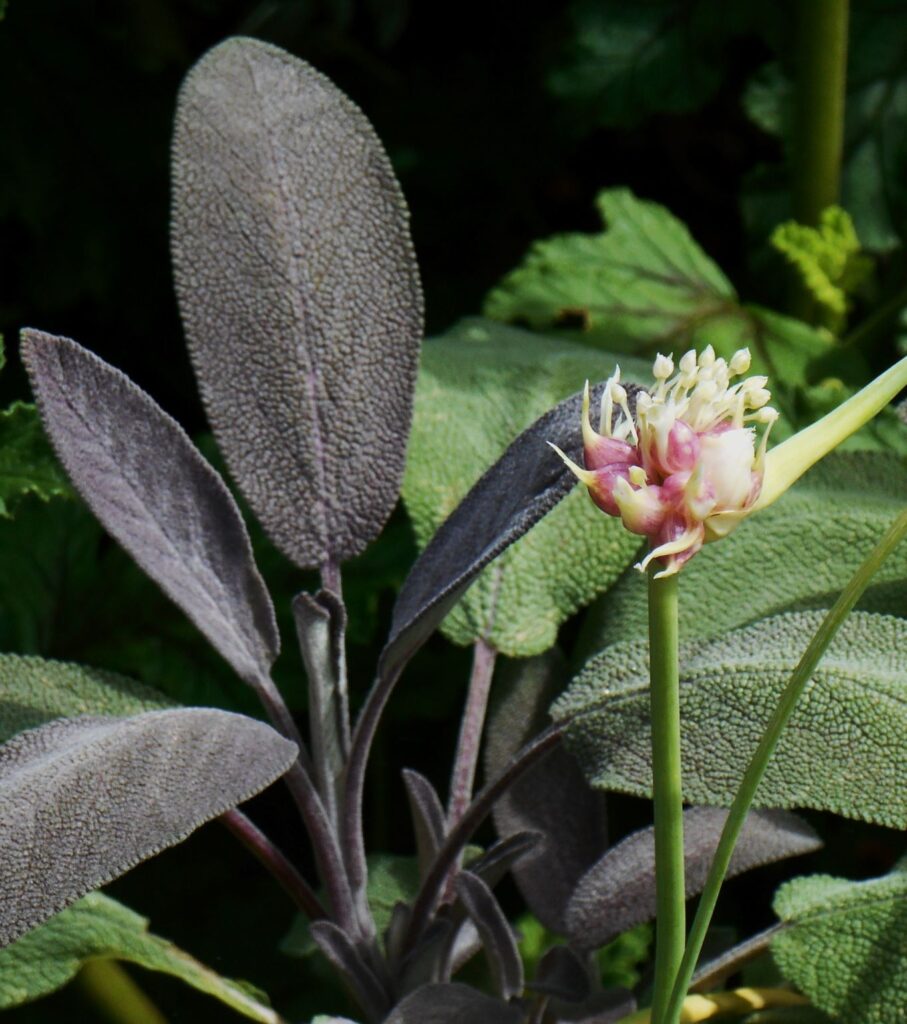
Salvia ‘Purpurascens’ with Allium
All Photos by E. L. McCoy

